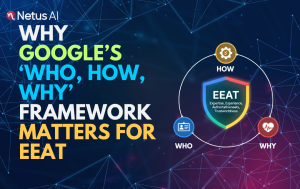
Why Google’s ‘Who, How, Why’ Framework Matters for EEAT | NetusAI
Why Google’s ‘Who, How, Why’ Framework Matters for EEAT AI can create articles in seconds. But here’s the truth: speed is not enough. Google wants

Content writer and editor for Netus.AI
how do teachers detect ai
Can Teachers Detect AI Writing? Artificial intelligence (AI) writing tools have become increasingly popular in recent years, allowing users to generate high-quality content with minimal effort. However, this rise in AI writing has raised concerns about the potential for plagiarism and cheating, particularly in educational settings. As such, the question arises: can teachers detect AI writing?
While AI writing tools have advanced significantly in recent years, they are not infallible. Teachers who are familiar with the typical writing style and abilities of their students may be able to identify when a piece of writing has been generated by an AI tool. Additionally, there are now detection tools available that can help teachers identify potential instances of AI-generated content. However, these tools are not foolproof and may not catch all instances of AI writing.
The use of AI writing tools in educational settings raises important questions about academic integrity and the role of technology in education. As AI technology continues to advance, it is important for educators to stay informed and aware of the potential risks and benefits of these tools. In this article, we will explore the topic of AI writing detection in more detail, examining the current state of the technology and its implications for teachers and students alike.
As artificial intelligence (AI) continues to advance, it is increasingly being integrated into various industries, including education. AI has the potential to revolutionize the way we learn and teach, making education more accessible, personalized, and efficient. In this section, we will explore the impact of AI on education, focusing on generative AI and AI tools in academic settings.
Generative AI, such as ChatGPT, has the ability to create human-like text, which can be used to generate educational materials. This technology can be used to create interactive and engaging learning experiences for students, allowing them to learn at their own pace and in their preferred style. For example, ChatGPT can be used to create chatbots that can answer students’ questions, provide feedback, and offer personalized learning recommendations.
Moreover, generative AI can be used to create virtual tutors that can adapt to students’ learning needs and provide personalized feedback. This technology can be especially useful for students who are struggling with certain subjects or concepts, as it can provide additional support and guidance.
AI tools are increasingly being used in academic settings to enhance teaching and learning. For example, AI-powered grading systems can provide fast and accurate feedback on assignments, allowing teachers to focus on providing more personalized feedback and support. AI can also be used to analyze student data and provide insights into their learning patterns, allowing teachers to identify areas where students may need additional support.
Moreover, AI-powered educational platforms can provide personalized learning experiences for students, allowing them to learn at their own pace and in their preferred style. These platforms can also provide real-time feedback and support, helping students to stay engaged and motivated.
In conclusion, AI has the potential to transform education, making it more accessible, personalized, and efficient. Generative AI and AI tools can be used to create interactive and engaging learning experiences, provide personalized feedback and support, and analyze student data to identify areas where additional support may be needed. As AI continues to advance, it will be interesting to see how it will be integrated into education and how it will impact the way we learn and teach.
AI detectors are programs that analyze text to determine whether it was generated by a human or an AI language model. These detectors typically use algorithms that analyze various aspects of the text, such as sentence structure, word choice, and grammar.
One popular AI detection tool is GPTZero, which uses a combination of statistical analysis and machine learning to detect AI-generated text. GPTZero is trained on large datasets of both human-written and AI-generated text, allowing it to accurately identify the differences between the two.
While AI detectors are generally effective at detecting AI-generated text, they are not perfect. One of the biggest challenges for AI detectors is false positives, where the detector incorrectly identifies human-written text as being generated by an AI model.
The accuracy rate of AI detectors can vary depending on the specific tool being used and the characteristics of the text being analyzed. In some cases, AI detectors may have an accuracy rate of over 90%, while in other cases the accuracy rate may be lower.
To minimize the risk of false positives, many AI detectors use multiple algorithms and techniques to analyze text. By using a combination of approaches, these detectors can achieve higher accuracy rates while reducing the risk of false positives.
Overall, AI detection is an important tool for ensuring the integrity of written content. As AI language models become increasingly sophisticated, it is likely that AI detectors will continue to evolve to keep pace with these advancements.
Despite the advancements in AI writing detection, there are still limitations in the technology that make it difficult to detect AI-generated text. One of the biggest limitations is the ability of AI to mimic human writing styles and patterns. This makes it challenging for teachers to differentiate between AI-generated text and text written by a human.
Another limitation of current technologies is the lack of standardization in AI writing detection. Different tools and software use different algorithms and metrics to detect AI-generated text, which can lead to inconsistencies in the results. This can make it difficult for teachers to rely on AI detectors as a reliable means of detecting AI-generated text.
Another challenge in detecting AI-generated text is dealing with false information. AI-generated text can be used to spread false information, which can have serious consequences. Detecting false information requires a high level of accuracy and precision, which is difficult to achieve with current technologies.
One experimental tool that has shown promise in detecting false information is AI Detector Pro. This tool uses machine learning algorithms to analyze text and identify patterns that are indicative of false information. However, more research is needed to determine the effectiveness of this tool in detecting AI-generated text.
In conclusion, while there have been advancements in AI writing detection, there are still challenges that need to be addressed. Limitations in current technologies and the spread of false information are just a few of the challenges that teachers face when trying to detect AI-generated text. It is important for researchers and developers to continue to improve AI writing detection technologies to help teachers detect AI-generated text more accurately.
Educators and professors play a critical role in promoting academic integrity. They are responsible for ensuring that their students adhere to ethical standards and guidelines when it comes to writing and research. To promote academic integrity, educators and professors can:
By taking these steps, educators and professors can help to promote a culture of academic integrity and discourage cheating and plagiarism.
AI-generated text has the potential to make it easier for students to cheat and engage in plagiarism. However, AI can also be used to help detect plagiarism and promote academic integrity. Plagiarism detection software that uses AI algorithms can quickly and accurately identify instances of plagiarism in student work.
To promote academic integrity, educators and professors can use AI-powered plagiarism detection software to check student work. This can help to deter students from engaging in unethical behavior and ensure that academic standards are upheld.
In conclusion, promoting academic integrity is crucial for maintaining the credibility and reputation of educational institutions. Educators and professors can play a key role in promoting academic integrity by educating students, providing clear guidelines, and using AI-powered plagiarism detection software to monitor student work.
In recent years, the use of AI writing tools has become increasingly popular among students and professionals alike. As a result, teachers are faced with the challenge of detecting AI-generated content. In Australia, Turnitin Products have been widely used to detect plagiarism. However, with the emergence of AI writing tools, Turnitin has had to adapt its detection methods to keep up with new technologies.
One such adaptation is the use of machine learning algorithms to detect patterns in writing that are indicative of AI-generated content. This has proved to be an effective method for detecting AI writing in English language assignments. However, the detection of AI writing in other languages has proven to be more challenging.
The use of AI writing tools is not limited to English language assignments. In fact, there has been a significant increase in the use of AI writing tools in Portuguese and Spanish language assignments. This has presented a new challenge for teachers who are not fluent in these languages.
To address this challenge, Annie Chechitelli, a researcher in the field of AI writing detection, has developed a machine learning algorithm that is capable of detecting AI-generated content in Portuguese and Spanish language assignments. The algorithm analyzes patterns in the writing that are indicative of AI-generated content and has proven to be effective in detecting AI writing in these languages.
In conclusion, the detection of AI writing is an ongoing challenge for teachers and educational institutions around the world. However, with the development of new technologies and methods, it is becoming increasingly possible to detect AI-generated content. As AI writing tools continue to evolve, it is important for teachers to stay up-to-date with the latest detection methods and technologies.

Why Google’s ‘Who, How, Why’ Framework Matters for EEAT AI can create articles in seconds. But here’s the truth: speed is not enough. Google wants
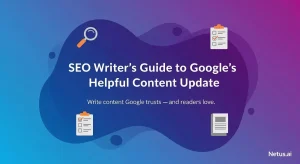
SEO Writer’s Guide to Google’s Helpful Content Update Keeping up with Google’s algorithm changes can feel like a relentless game of whack-a-mole. Just when you

Can AI Content Be Safe for SEO in 2025? Let’s start with the question of keeping every content strategist, SEO pro and blogger awake at
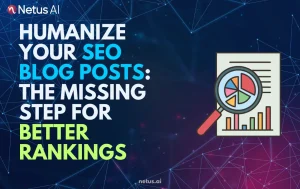
Humanize Your SEO Blog Posts: The Missing Step for Better Rankings You’ve done everything by the book. Your keyword research is impeccable. Your meta descriptions
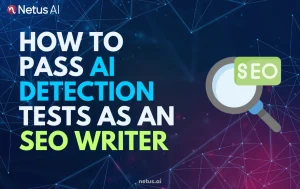
How to Pass AI Detection Tests as an SEO Writer Let’s paint a familiar picture. You’ve just finished a blog post. The headline is sharp,
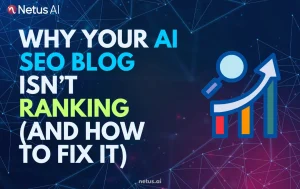
Why Your AI SEO Blog Isn’t Ranking (And How to Fix It) You embraced AI for your blog. The promise was intoxicating: high-quality content, published
@ 2024 Netus AI.